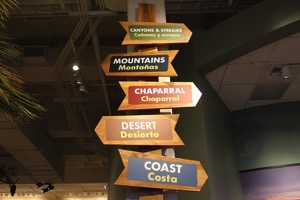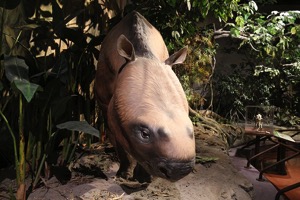
It’s about that time of year when our friends and family come to visit and we end up doing the tourist stuff we don’t normally do on our own. Many cultural events have been planned around Balboa Park’s 2015 centennial celebration this year including the much-anticipated Coast to Cactus: In Southern California at the San Diego Natural History Museum.
There were over 100 people that came together from concept to completion. “We have a core team here at San Diego Natural History Museum but then we work with Science Museum of Minnesota,” said Exhibit Developer Erica Kelley describing the amazing work that happened behind the scenes to bring the display to fruition. She said that it’s been over a decade since the museum did its last strategic plan and they always knew they wanted to do a Fossil Mysteries and a Habitat Exhibit.
Even if you think you know everything there is to know about San Diego, you’ll discover there’s more to see. The region is one of only thirty-five biodiversity hotspots in the world and because of its diverse terrain it has one of the highest concentrations of different species of any geographic area of similar size. We can go to the beach, desert and mountains in one day experiencing changes in climate and our surroundings. Besides the natural history of San Diego, you will also learn about the imported plants and animals that have re-shaped the atmosphere as well.

Some of the exhibition highlights include an oversized replica of a segment of mud from a local tidal flat. Kids can crawl inside the replica to experience how animals survive in the mudflats. There’s also a virtual storybook that tells the tale of the chaparral ecosystem and how periodic fires are a natural and necessary part of life for the California habitat.

Adjacent to the exhibition is Fossil Mysteries, which gives visitors a glimpse of prehistoric times of the area. The fossils are from Southern California and Baja California during the Cretaceous (kreh TAY shus) Period. You can examine fossil skulls and skeletons and learn how to identify how they lived and what they ate. It’s interesting to note that not all animals are carnivores. Interactive activities include opportunities to touch real fossils and rocks, examine and identify microfossils and find and identify plants and animals in the woodlands and lagoons of prehistoric San Diego County.

These two exhibits give you a complete picture of Southern California from the prehistoric era to the present day.
The exhibitions are located in the Dennis and Carol Wilson Hall of Biodiversity on Level 2 of the Museum. All information within Coast to Cactus is presented in both English and Spanish.
More information: http://www.sdnhm.org/











